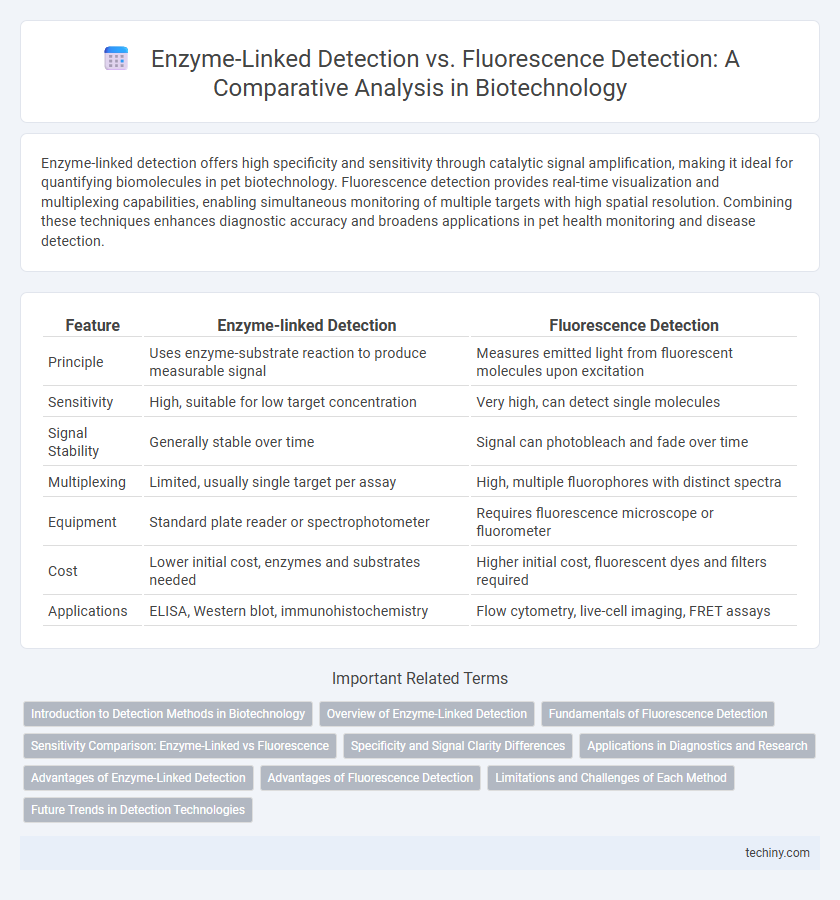Enzyme-linked detection offers high specificity and sensitivity through catalytic signal amplification, making it ideal for quantifying biomolecules in pet biotechnology. Fluorescence detection provides real-time visualization and multiplexing capabilities, enabling simultaneous monitoring of multiple targets with high spatial resolution. Combining these techniques enhances diagnostic accuracy and broadens applications in pet health monitoring and disease detection.
Table of Comparison
| Feature | Enzyme-linked Detection | Fluorescence Detection |
|---|---|---|
| Principle | Uses enzyme-substrate reaction to produce measurable signal | Measures emitted light from fluorescent molecules upon excitation |
| Sensitivity | High, suitable for low target concentration | Very high, can detect single molecules |
| Signal Stability | Generally stable over time | Signal can photobleach and fade over time |
| Multiplexing | Limited, usually single target per assay | High, multiple fluorophores with distinct spectra |
| Equipment | Standard plate reader or spectrophotometer | Requires fluorescence microscope or fluorometer |
| Cost | Lower initial cost, enzymes and substrates needed | Higher initial cost, fluorescent dyes and filters required |
| Applications | ELISA, Western blot, immunohistochemistry | Flow cytometry, live-cell imaging, FRET assays |
Introduction to Detection Methods in Biotechnology
Enzyme-linked detection utilizes enzyme-labeled antibodies to produce a colorimetric or chemiluminescent signal, providing high specificity and sensitivity in identifying target biomolecules. Fluorescence detection employs fluorophore-labeled probes that emit light upon excitation, enabling real-time monitoring and multiplexing capabilities in complex biological samples. Both methods are essential in biotechnology for accurate quantification and visualization of proteins, nucleic acids, and other analytes in research and diagnostic applications.
Overview of Enzyme-Linked Detection
Enzyme-linked detection utilizes enzymes such as horseradish peroxidase or alkaline phosphatase as biochemical labels that catalyze substrate reactions, producing measurable colorimetric changes. This method offers high sensitivity and specificity in detecting target molecules, widely applied in ELISA assays for protein or nucleic acid quantification. The amplification of signals through enzyme activity enables reliable detection even at low analyte concentrations, making it essential in diagnostics and research.
Fundamentals of Fluorescence Detection
Fluorescence detection relies on the excitation of fluorescent molecules called fluorophores, which emit light at a specific wavelength after absorbing energy, enabling highly sensitive and specific measurement in biological assays. This technique offers rapid signal generation and is widely used for analyzing nucleic acids, proteins, and cellular components due to its superior signal-to-noise ratio compared to enzyme-linked detection. Key factors in fluorescence detection include fluorophore stability, quantum yield, and excitation/emission spectra, which directly influence assay sensitivity and quantitative accuracy.
Sensitivity Comparison: Enzyme-Linked vs Fluorescence
Enzyme-linked detection methods, such as ELISA, offer high sensitivity by amplifying the signal through enzyme-substrate reactions, often achieving detection limits in the picomolar range. Fluorescence detection techniques provide superior sensitivity with lower background noise and enable multiplexing, allowing detection down to femtomolar concentrations. Comparative studies reveal fluorescence detection typically surpasses enzyme-linked assays in sensitivity, making it preferable for applications requiring ultra-trace analyte quantification.
Specificity and Signal Clarity Differences
Enzyme-linked detection provides high specificity through antibody-enzyme interactions, producing amplified colorimetric signals that reduce background noise for clear results. Fluorescence detection offers superior signal clarity with multifunctional fluorescent tags, enabling multiplexing and real-time analysis despite potential photobleaching challenges. Enzyme-linked methods excel in robust, stable readouts, whereas fluorescence detection delivers enhanced sensitivity and spatial resolution in complex biological samples.
Applications in Diagnostics and Research
Enzyme-linked detection, such as ELISA, offers high sensitivity and specificity for identifying proteins, hormones, and pathogens in clinical diagnostics and biomarker research. Fluorescence detection enables multiplexing and real-time monitoring of biological processes, making it invaluable for live-cell imaging and nucleic acid quantification in molecular diagnostics. Both methods complement each other by providing robust quantitative data essential for disease diagnosis and therapeutic research.
Advantages of Enzyme-Linked Detection
Enzyme-linked detection offers higher sensitivity due to enzymatic signal amplification, enabling the detection of low-abundance biomolecules with greater accuracy. This method provides cost-effective and stable results, as enzymes produce long-lasting colorimetric signals that do not require specialized instrumentation. Enhanced quantification and adaptability in various assay formats make enzyme-linked detection a valuable tool in biotechnology applications such as ELISA and Western blotting.
Advantages of Fluorescence Detection
Fluorescence detection offers higher sensitivity and specificity compared to enzyme-linked detection, enabling the identification of low-abundance biomolecules with greater accuracy. It provides real-time monitoring capabilities and multiplexing options, facilitating simultaneous detection of multiple targets in a single assay. The method also reduces signal degradation and background noise, ensuring more reliable and quantitative results in biotechnology applications.
Limitations and Challenges of Each Method
Enzyme-linked detection faces limitations such as enzyme instability and substrate specificity that can lead to variable signal intensity and longer assay times. Fluorescence detection struggles with photobleaching, background autofluorescence, and requires expensive equipment with precise calibration for accurate quantification. Both methods encounter challenges in sensitivity, reproducibility, and interference from complex biological samples that impact overall detection accuracy.
Future Trends in Detection Technologies
Future trends in detection technologies emphasize enhanced sensitivity, multiplexing capabilities, and real-time analysis in enzyme-linked detection and fluorescence detection methods. Advances in nanomaterials and quantum dots are driving the development of ultra-sensitive fluorescence assays, while integration with microfluidics and lab-on-a-chip platforms is revolutionizing enzyme-linked immunosorbent assays (ELISAs) for rapid, point-of-care diagnostics. The convergence of artificial intelligence with detection technologies is expected to optimize assay design and data interpretation, accelerating breakthroughs in biomedical research and personalized medicine.
**Enzyme-linked detection vs Fluorescence detection** Infographic

 techiny.com
techiny.com